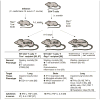Understanding mechanisms underlying the pathology of immune reconstitution inflammatory syndrome (IRIS) by using animal models
- PMID: 30555775
- PMCID: PMC6291227
- DOI: 10.1007/s40588-018-0099-5
Understanding mechanisms underlying the pathology of immune reconstitution inflammatory syndrome (IRIS) by using animal models
Abstract
Purpose of review: Despite the increasing number of clinical reports on immune reconstitution inflammatory syndrome (IRIS), mechanistic understanding of IRIS is still largely limited. The main focus of this review is to summarize animal studies, which were performed to better understand the cellular and molecular mechanisms underlying the pathology of IRIS.
Recent findings: Three IRIS animal models have been reported. They are Mycobacterial IRIS (M-IRIS), cryptococcal IRIS (C-IRIS) and Pneumocystis-IRIS. M-IRIS animal model suggested that, rather than lymphopenia itself, the failure to clear the pathogen by T cells results in excessive priming of the innate immune system. If this happens before T cell reconstitution, hosts likely suffer IRIS upon T cell reconstitution. Interestingly, T cells specific to self-antigens, not only pathogen-specific, could drive IRIS as well.
Summary: The mechanism to develop IRIS is quite complicated, including multiple layers of host immune responses; the innate immune system that detects pathogens and prime host immunity, and the adaptive immune system that is reconstituted but hyper-activated particularly through CD4+ T cells. Animal models of IRIS, although there are still small numbers of studies available, have already provided significant insights on the mechanistic understanding of IRIS.
Keywords: Cryptococcus neoformans; IRIS; Immune reconstitution; Mycobacterium avium; Opportunistic infection; Pneumocystis.
Figures
Similar articles
-
CD4+ T Cells Orchestrate Lethal Immune Pathology despite Fungal Clearance during Cryptococcus neoformans Meningoencephalitis.mBio. 2017 Nov 21;8(6):e01415-17. doi: 10.1128/mBio.01415-17. mBio. 2017. PMID: 29162707 Free PMC article.
-
A novel experimental model of Cryptococcus neoformans-related immune reconstitution inflammatory syndrome (IRIS) provides insights into pathogenesis.Eur J Immunol. 2015 Dec;45(12):3339-50. doi: 10.1002/eji.201545689. Epub 2015 Oct 12. Eur J Immunol. 2015. PMID: 26381487
-
Immune reconstitution inflammatory syndrome associated with pulmonary pathogens.Eur Respir Rev. 2017 Jan 3;26(143):160042. doi: 10.1183/16000617.0042-2016. Print 2017 Jan. Eur Respir Rev. 2017. PMID: 28049128 Free PMC article. Review.
-
Pathogenesis of the immune reconstitution inflammatory syndrome in HIV-infected patients.Curr Opin Infect Dis. 2012 Jun;25(3):312-20. doi: 10.1097/QCO.0b013e328352b664. Curr Opin Infect Dis. 2012. PMID: 22562000 Review.
-
Robust Reconstitution of Tuberculosis-Specific Polyfunctional CD4+ T-Cell Responses and Rising Systemic Interleukin 6 in Paradoxical Tuberculosis-Associated Immune Reconstitution Inflammatory Syndrome.Clin Infect Dis. 2016 Mar 15;62(6):795-803. doi: 10.1093/cid/civ978. Epub 2015 Nov 26. Clin Infect Dis. 2016. PMID: 26611774 Free PMC article.
Cited by
-
Th1-Dependent Cryptococcus-Associated Immune Reconstitution Inflammatory Syndrome Model With Brain Damage.Front Immunol. 2020 Sep 29;11:529219. doi: 10.3389/fimmu.2020.529219. eCollection 2020. Front Immunol. 2020. PMID: 33133067 Free PMC article.
-
Host immune responses in the central nervous system during fungal infections.Immunol Rev. 2022 Oct;311(1):50-74. doi: 10.1111/imr.13101. Epub 2022 Jun 7. Immunol Rev. 2022. PMID: 35672656 Free PMC article. Review.
-
Immune Reconstitution Syndrome Caused by Nontuberculous Mycobacteria: A Case Report and Review of Literature.Cureus. 2024 Jul 9;16(7):e64146. doi: 10.7759/cureus.64146. eCollection 2024 Jul. Cureus. 2024. PMID: 39119403 Free PMC article.
-
Co-infections as Modulators of Disease Outcome: Minor Players or Major Players?Front Microbiol. 2021 Jul 6;12:664386. doi: 10.3389/fmicb.2021.664386. eCollection 2021. Front Microbiol. 2021. PMID: 34295314 Free PMC article. Review.
-
Niflumic Acid Reverses Airway Mucus Excess and Improves Survival in the Rat Model of Steroid-Induced Pneumocystis Pneumonia.Front Microbiol. 2019 Jul 5;10:1522. doi: 10.3389/fmicb.2019.01522. eCollection 2019. Front Microbiol. 2019. PMID: 31333624 Free PMC article.
References
-
- Sun H-Y, Singh N. Opportunistic Infection-Associated Immune Reconstitution Syndrome in Transplant Recipients. Clinical Infectious Diseases. 2011;53(2):168–76. - PubMed
-
- Miceli MH, Maertens J, Buve K, Grazziutti M, Woods G, Rahman M, et al. Immune reconstitution inflammatory syndrome in cancer patients with pulmonary aspergillosis recovering from neutropenia: Proof of principle, description, and clinical and research implications. Cancer. 2007;110(1):112–20. - PubMed
-
- Cadena J, Thompson GR, 3rd, Ho TT, Medina E, Hughes DW, Patterson TF. Immune reconstitution inflammatory syndrome after cessation of the tumor necrosis factor alpha blocker adalimumab in cryptococcal pneumonia. Diagn Microbiol Infect Dis. 2009;64(3):327–30. - PubMed
-
- Fine AJ, Sorbello A, Kortepeter C, Scarazzini L. Progressive multifocal leukoencephalopathy after natalizumab discontinuation. Ann Neurol. 2014;75(1):108–15. - PubMed
Grants and funding
LinkOut - more resources
Full Text Sources
Research Materials

